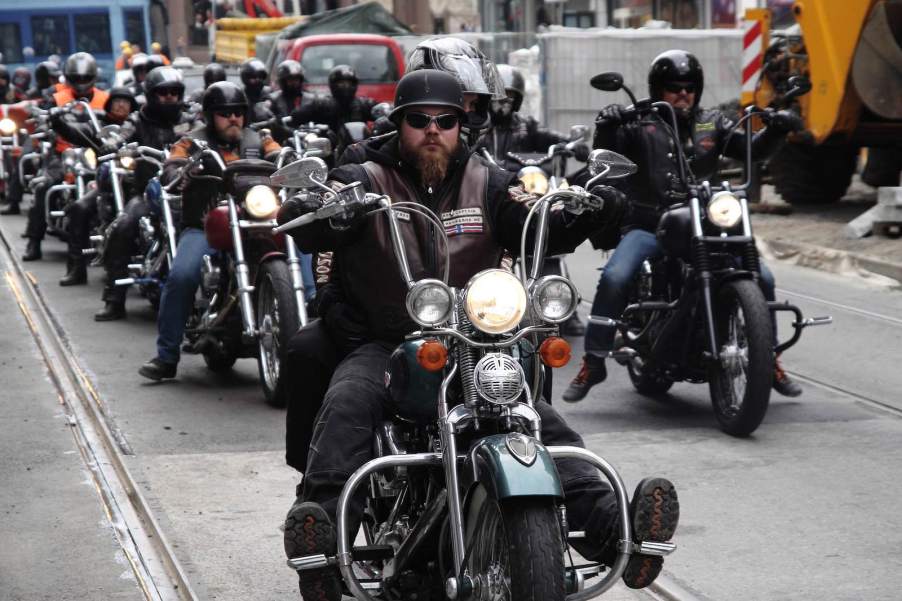
How to Tell if Motorcyclists Are in a Gang
So you were re-watching “The Sons of Anarchy” the other day and wondered, How can I tell if bikers on the road are in a gang? Here is your guide to “riding clubs,” “motorcycle clubs,” and even “outlaw” clubs. All three are explained in detail below.
Patches that often signal an “outlaw motorcycle club”
- 1%er front patch or 1% logo in club patch
- Back patch with common outlaw club name: Hells Angels, Outlaws, Bandidos, etc.
- “Bottom rocker” banner claiming a territory
First of all, there are 8.8 million motorcyclists in the United States. That’s more people than the total population of New York City. The vast majority of these folks aren’t in a club at all. In biker parlance, they’re “lone wolves.”
But many motorcyclists prefer riding with friends. So there are countless “riding clubs” that go out for cruises together. There are also “motorcycle clubs” that tend to have a more social aspect, but not always. There are clubs of folks from the same neighborhood who all happen to have motorcycles, there are clubs for folks who all ride the same unique brand, there are even clubs for people who have certain professions or heritage. This can range from dentist motorcycle clubs to Irish-American motorcycle clubs.
Now this is important: no biker would say they are in a “gang.” But there are several “outlaw motorcycle clubs” in the U.S. Many were founded by veterans returning from WWII. And they are all territory-based.
These bikers represent just a fraction of the motorcyclists in the U.S. But they are a very popular subject in movies and TV shows. By the 1960s, they were hurting the image of motorcycles enough that the American Motorcyclist Association held a famous press conference to declare that “99% of motorcyclists are law-abiding citizens.”

Many outlaw motorcycle clubs responded by adding a “1%er” patch to the front of their outfits. So that is a dead give away of an outlaw biker. But that is not the only unique patch they wear.
Many motorcyclists, including many outlaw motorcycle clubs, sew patches on to a vest or “cut.” Why a vest? So they can wear it with a variety of outfits, including over their riding leathers. And many of these folks reserve the back of the vest for a large patch with their club’s logo. And just in case you don’t get the point, they’ll often have a banner with the club’s name above that patch. This is called a “top rocker.” But a logo and top rocker doesn’t mean you’re looking at an outlaw motorcyclist.
An outlaw motorcycle club will always add a “bottom rocker” or a banner beneath the logo. This banner will show their territory. Depending on the club, this may be an entire state. Or it may be a region of a state. This is important because originally outlaw motorcycle clubs wouldn’t allow any other clubs to claim the exact same territory. If a “challenger” club tried to claim it, they’d deal with the challenge “outside of the law.” This was the original meaning of the term “outlaw motorcycle club.”

Increasingly, a regular motorcycle club will have a bottom rocker with their territory. But in some places, they are asking for trouble by wearing this. If a club wears a bottom rocker with something as broad as a country name, they may be in the clear. In addition, these tend to be special interest clubs that clearly aren’t outlaws. Examples include the “Harley Owners Group” or a club for a specific fire department or police force.
The five largest outlaw motorcycle clubs in the United States (according to the DoJ) are the Hells Angels, Mongols, Bandidos, Outlaws, and Sons of Silence. The Pagans are also a major club. These clubs each have a standard patch. They all also have individual chapters, each of which claims a different territory with a unique bottom rocker. But not every 1%er rides with one of these clubs. Some belong to smaller regional clubs, many of which have just one chapter but have managed to claim a bit of territory from the larger clubs.
Learn more about life in a motorcycle club from an ex Hell’s Angels member in the video below:




